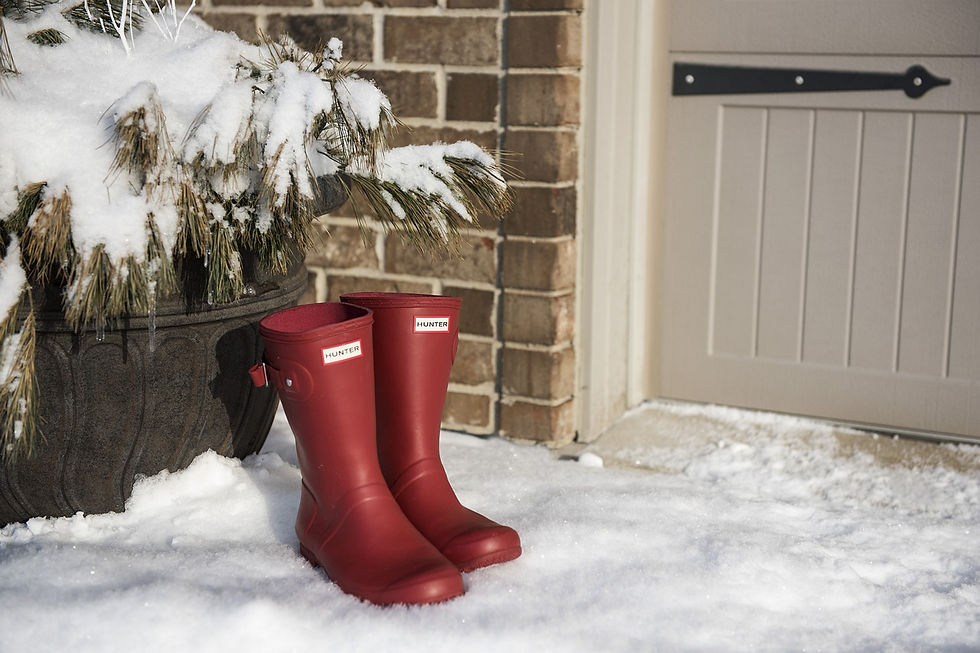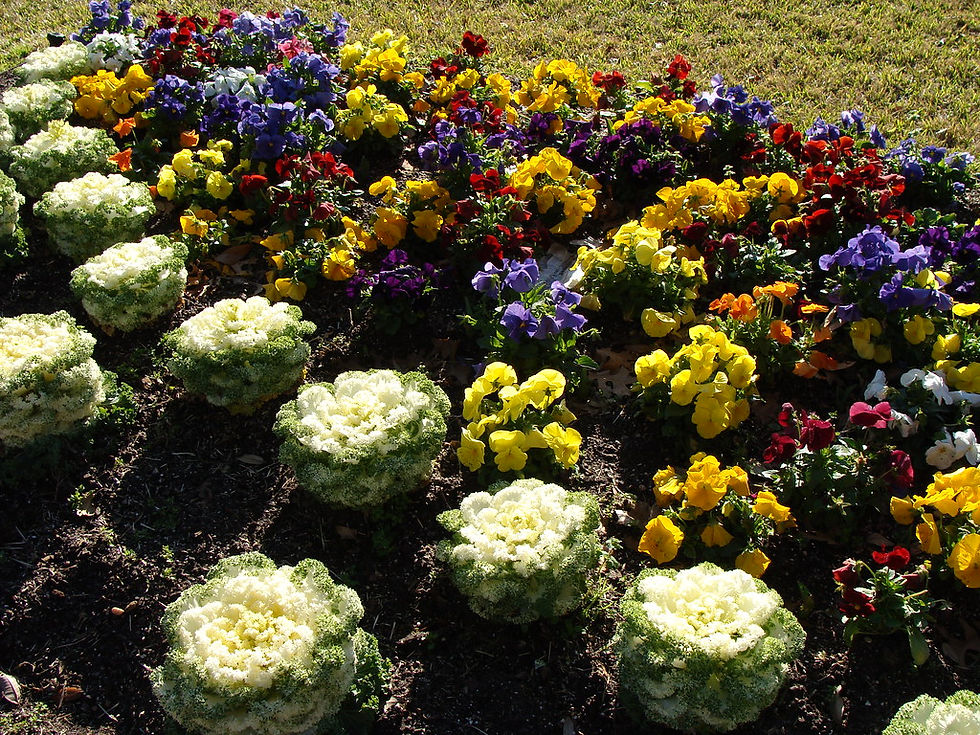Winter Gardening Fun for North Texans
- Marshall Grain Co.

- Jan 11, 2024
- 6 min read
Why spend the winter indoors when you could be outside playing in your garden? North Texas winters are usually mild enough to accommodate many outdoor gardening activities. You can even grow a variety of seasonal flowers and edibles. Here are some suggestions for how to cheer up yourself and your garden during the dark of winter.

What Is Organic Gardening?
Winter is the perfect time to make the switch to organic gardening methods. Organic gardeners work in harmony with nature to promote a balanced eco-system. Chemical fertilizers, pesticides and herbicides kill off both beneficial and harmful insects as well as other essential organisms in your garden, robbing you of valuable allies. Instead, organic methods put all those beneficial creatures to work for you. They not only help you control the bad guys that would eat your plants, but they are safer for your children and pets. You won’t be exposing yourself or your family to chemicals that might cause cancer, induce allergies, or cause other health problems.
Organic soil also makes for healthier plants because they are better able to utilize the nutrients they need. Healthy soil is also more porous and absorbent, so, over time, you will use less water, less fertilizer, and fewer other ingredients, which will also save you money. If you enjoy bird watching or butterflies, being organic makes your yard more attractive to wildlife.

Experience Winter Gardening Joy
Now you're ready to dive into your winter garden. Each of the sections below provides tips for keeping your gardening healthy and thriving through the winter.
Fall Cleanup
Prepare for Winter
Decorate for the Holidays
Edibles & Flowers to Plant
Pruning
Prepare for Spring
Fall Cleanup
Typically by Thanksgiving, most of your garden will be dormant. Leaves will have fallen and most perennials will have gone dormant, which makes it a good time to clean out your flowerbeds by removing any dead plant material. You should also rake up leaves from your lawn and beds and remove any weeds.
If you have a compost pile, make sure you only add healthy plant material to it. Never recycle diseased material. Infected material should be disposed of in the trash only.

Harvest any warm season fruits, vegetables, and other edibles prior to any frost or freeze. Vegetables such as tomatoes will die quickly when the temperature falls below 50º F. Our first frost typically occurs around mid-November, however, our weather is highly variable, so it is important to always watch the weather rather than relying on the calendar.
Once you've cleaned up and harvested your warm season crops, you can top dress your beds with compost and other soil amendments such as lava sand, green sand, and dry molasses. You can also apply corn gluten meal to suppress weeds.
Prepare for Winter and Plan for Spring
Cold weather can surprise us almost any time between November and March, so be sure to prepare yourself for it. Keep frost cloth handy so that you can cover cold-tender crops on short notice. Harvest tomatoes, peppers, and any other warm season vegetables before overnight temperatures dip below 40ºF. Protect your outdoor faucets by wrapping them with burlap or a removable Styrofoam cover.
Move Containers Indoors
Potted plants such as citrus trees and tropical plants should be moved indoors before any chance of frost. On warmer days you can move them back outside again for a few hours to give them needed sunlight.
Apply Corn Gluten Meal & Fertilizer Your Lawn
Weed seeds can germinate anytime the soil temperature is between approximately 50ºF and 75ºF, which means that you need to apply Corn Gluten Meal as a pre-emergent herbicide at least twice per year in spring and fall. Depending on the weather, you may want to make two or even three applications between September and January to keep weeds to a minimum.
It's also important to "winterize" your lawn in the fall with an application of a low-nitrogen organic fertilizer. Although your lawn may be in dormancy, the roots are still active and need to be fed during this time.

Mulch, Mulch, Mulch!
It's never too early to mulch. Adding a nice thick layer of organic mulch (wood, leaves, straw, or other compostable material) provides a continuous source of fresh organic matter for your plants while also insulating them against the weather. It also suppresses weeds and gives garden friendlies such as ladybugs and lizards places to hibernate and warm themselves.

Divide Perennials & Move Bulbs
Over time your perennials and bulbs may become over crowded in their original locations and you may want to divide them and spread them out or add some to new areas of your garden. Late November through December is the ideal time to divide your spring-blooming bulbs and perennials. When dividing bulbs, carefully dig them up so as to not damage them and then replant them in their new locations. Perennials are less fragile, but you should still use care to not damage your plants.
Harvest Rose Hips
Harvest rose hips immediately after the first frost. Use these edible fruits in the kitchen to make tea, crush into powder, dissolve into an essential oil or create other healthful recipes.
Over-Seed Lawns & Plant Cover Crops
If you're the type who likes to have a green lawn all year round, you'll want to over-seed your warm-season St. Augustine or Bermuda lawn with Ryegrass. Ryegrass is a fast-germinating, fast-growing lawn grass that can be thrown out on top of your existing lawn. When the weather warms up again, the Ryegrass will die and your permanent turf will re-emerge from dormancy.
Ryegrass can also be used as a cover crop for your empty beds or other bare areas. Cover crops such as cowpeas, oats, soybeans, and clover restore lost nitrogen into the soil. Many North Texas gardeners plant cover crops each winter to help keep their gardens healthy.
Sow Wildflower Seeds
Sowing wildflower seeds is a fun and inexpensive way to fill in your garden, as well as a way to enjoy our native flora. Children especially love planting seeds, making it an excellent family activity. Most Texas native wildflower seeds, including Bluebonnets, need to be sown between October and November so that they can received the required number of chilling hours to successfully bloom the following spring.
Decorate for the Holidays
One way to relieve the dreariness of winter is to dress up your garden for the holidays. Halloween, Thanksgiving, Christmas, Hanukkah, and Diwali are just some of the opportunities for winter decorating activities and your garden may even provide the raw materials.

Latinos are famous for creating "Ristras" made from their own garden grown chili peppers. Ristras serve as a symbol of welcome as well as a way to dry and preserve the pepper harvest.
For Halloween there's nothing like pumpkins, corn stalks, straw bales, and chrysanthemums.
While Holly is the typical go-to plant for wreath making, Eleagnus (Silverberry) is also a beautiful alternative. Accented by large red edible fruits, the Eleagnus' grayish-green arching branches can be woven into a hanging display for your door or used to create a centerpiece for your dining room table.
Diwali is a Hindu holiday that, while the story varies from one part of India to another, broadly speaking, it celebrates the triumph of light over darkness. It's generally honored with a "festival of lights," fireworks shows, and, of course, traditional foods.
Keep Growing!
In North Texas we can grow a variety of cool season flowers and edibles through the winter Most will even survive short periods of extreme cold if they are covered with frost cloth. Here are a few suggestions:
Flowers You Can Grow in Winter
Pansies
Cyclamen
Hellebores (Lenten Rose)
Snapdragons
Lobelia
Dusty Miller
Ornamental Vegetables (Cabbage, Kale)

Cool Season Edibles
Many vegetable crops thrive in temperatures between 60º and 65ºF and can even tolerate temperatures as low as 20ºF. Cool season vegetables include:
Lettuce
Broccoli
Cauliflower
Brussels Sprouts
Cabbage
Kale
Mustard
Spinach
You can succession plant these and continue to enjoy harvests from October through April or May.
Other Winter Tasks & Activities
Bird watching is a popular pastime and birds, and winter is a time when their natural food supplies run low. Putting out feeders provides them with a steady food source and you with regular entertainment as you watch them feast on your offerings.
After all the leaves have fallen is also a great time to clean out your gutters. This will ensure proper drainage and prevent damage.

Conclusion
Keeping active and getting outdoors is important for your metal and physical healthy. But cold weather can make it especially challenging to get out. Having enjoyable outdoor activities to look forward to can help motivate you to put on your coat and dig in.






